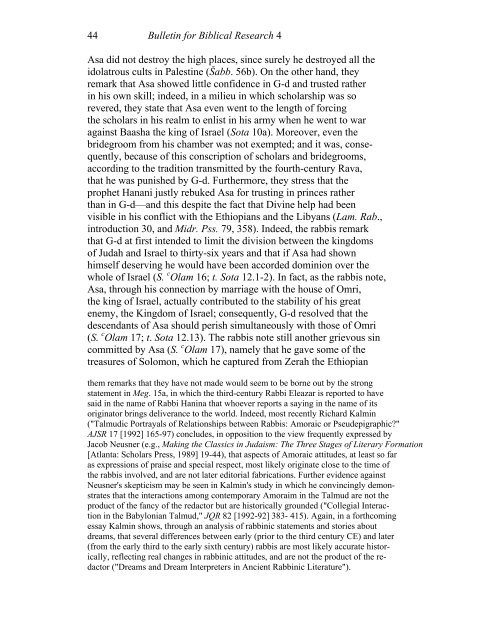Josephus' Portrait of Asa - Institute for Biblical Research
Josephus' Portrait of Asa - Institute for Biblical Research
Josephus' Portrait of Asa - Institute for Biblical Research
You also want an ePaper? Increase the reach of your titles
YUMPU automatically turns print PDFs into web optimized ePapers that Google loves.
44 Bulletin <strong>for</strong> <strong>Biblical</strong> <strong>Research</strong> 4<br />
<strong>Asa</strong> did not destroy the high places, since surely he destroyed all the<br />
idolatrous cults in Palestine (Šabb. 56b). On the other hand, they<br />
remark that <strong>Asa</strong> showed little confidence in G-d and trusted rather<br />
in his own skill; indeed, in a milieu in which scholarship was so<br />
revered, they state that <strong>Asa</strong> even went to the length <strong>of</strong> <strong>for</strong>cing<br />
the scholars in his realm to enlist in his army when he went to war<br />
against Baasha the king <strong>of</strong> Israel (Sota 10a). Moreover, even the<br />
bridegroom from his chamber was not exempted; and it was, consequently,<br />
because <strong>of</strong> this conscription <strong>of</strong> scholars and bridegrooms,<br />
according to the tradition transmitted by the fourth-century Rava,<br />
that he was punished by G-d. Furthermore, they stress that the<br />
prophet Hanani justly rebuked <strong>Asa</strong> <strong>for</strong> trusting in princes rather<br />
than in G-d—and this despite the fact that Divine help had been<br />
visible in his conflict with the Ethiopians and the Libyans (Lam. Rab.,<br />
introduction 30, and Midr. Pss. 79, 358). Indeed, the rabbis remark<br />
that G-d at first intended to limit the division between the kingdoms<br />
<strong>of</strong> Judah and Israel to thirty-six years and that if <strong>Asa</strong> had shown<br />
himself deserving he would have been accorded dominion over the<br />
whole <strong>of</strong> Israel (S. c Olam 16; t. Sota 12.1-2). In fact, as the rabbis note,<br />
<strong>Asa</strong>, through his connection by marriage with the house <strong>of</strong> Omri,<br />
the king <strong>of</strong> Israel, actually contributed to the stability <strong>of</strong> his great<br />
enemy, the Kingdom <strong>of</strong> Israel; consequently, G-d resolved that the<br />
descendants <strong>of</strong> <strong>Asa</strong> should perish simultaneously with those <strong>of</strong> Omri<br />
(S. c Olam 17; t. Sota 12.13). The rabbis note still another grievous sin<br />
committed by <strong>Asa</strong> (S. c Olam 17), namely that he gave some <strong>of</strong> the<br />
treasures <strong>of</strong> Solomon, which he captured from Zerah the Ethiopian<br />
them remarks that they have not made would seem to be borne out by the strong<br />
statement in Meg. 15a, in which the third-century Rabbi Eleazar is reported to have<br />
said in the name <strong>of</strong> Rabbi Hanina that whoever reports a saying in the name <strong>of</strong> its<br />
originator brings deliverance to the world. Indeed, most recently Richard Kalmin<br />
("Talmudic Portrayals <strong>of</strong> Relationships between Rabbis: Amoraic or Pseudepigraphic?"<br />
AJSR 17 [1992] 165-97) concludes, in opposition to the view frequently expressed by<br />
Jacob Neusner (e.g., Making the Classics in Judaism: The Three Stages <strong>of</strong> Literary Formation<br />
[Atlanta: Scholars Press, 1989] 19-44), that aspects <strong>of</strong> Amoraic attitudes, at least so far<br />
as expressions <strong>of</strong> praise and special respect, most likely originate close to the time <strong>of</strong><br />
the rabbis involved, and are not later editorial fabrications. Further evidence against<br />
Neusner's skepticism may be seen in Kalmin's study in which he convincingly demonstrates<br />
that the interactions among contemporary Amoraim in the Talmud are not the<br />
product <strong>of</strong> the fancy <strong>of</strong> the redactor but are historically grounded ("Collegial Interaction<br />
in the Babylonian Talmud," JQR 82 [1992-92] 383- 415). Again, in a <strong>for</strong>thcoming<br />
essay Kalmin shows, through an analysis <strong>of</strong> rabbinic statements and stories about<br />
dreams, that several differences between early (prior to the third century CE) and later<br />
(from the early third to the early sixth century) rabbis are most likely accurate historically,<br />
reflecting real changes in rabbinic attitudes, and are not the product <strong>of</strong> the redactor<br />
("Dreams and Dream Interpreters in Ancient Rabbinic Literature").

















